June 18, 2019 at 9:44 pm

On a beautiful May day, I had the pleasure to visit an island off the coast of Portland. After a short boat ride from a local captain and an even shorter dinghy ride, we arrived on the shore of Ram Island. Accompanied by MDIFW biologists Danielle D'Auria and Brad Allen and U.S. Fish and Wildlife Service biologists Bob Houston and Kirstin Underwood, I looked on with binoculars to get a feel for the bird diversity on the island. I was blown away immediately by the sight of all the birds. I could see everything from gulls to egrets, sandpipers, and oystercatchers. The coastline was rocky and marked with cliffs and vegetation that were perfect nesting habitat for gulls and eiders. The center of the island was very green with dense vegetation, perfect for wading birds.

Once on shore, we combed through thick vines and raspberry bushes to search for nests. We had come all this way to collect data on nesting wading birds. The goal was to strategically walk a transect across the island and count all the nests, identifying them by species. This was easier said than done. We came across our fair share of vegetation walls, thorns, and stinging nettle. Scrambling through such thick vegetation can be disruptive to the nesting birds, so this type of census is not done annually; the last time IFW biologists were here was ten years ago. By doing this survey, we can get a good picture of how these colonial nesting water birds are doing on the coast of Maine. We are able to see which species are present and the number of nests can tell us if population trends are increasing or decreasing.
The island did not disappoint. There was no shortage of birds or their nests. Black-crowned night-herons, an endangered species in the state of Maine, were all over the island, with many nests already containing freshly hatched chicks. It was great news that this visit showed an increase in the number of black-crowned night-heron nests from a similar survey, conducted ten years ago. Among the glossy ibis and great blue heron nests, we were also able to see rare great egrets, guarding two nests on the island. Keeping an eye on the shrubs was important to find the stick nests created by all of these wading birds, but equally important was watching our step on the ground. Female common eiders hid in the grass and short shrubs all over the island, sitting on eggs and sometimes small ducklings. We also came across an American crow nest and some double-crested cormorant nests.
The wading bird colony on the island was incredible to survey. Often times multiple species had built nests in the same small tree, just feet apart. Distinguishing the nests apart is always difficult, but using guides and models for egg size, we were able to confidently identify the nests. All of these wading birds build stick nests and lay blue eggs. Egg shape, size, and color can often point to which species laid them, however, some nests contained drastically different looking eggs. When the nests were too high, we used a mirror on a pole to peak in and see what was up there. About 30% of the nests we surveyed had already hatched. Seeing the nestlings was an easy identification: black with a striped bill was glossy ibis; white chicks were either great or snowy egrets; and grayish color chicks are black-crowned night-herons . Great egrets have a more yellow bill and eye compared to snowy egrets which have darker eyes and bills.
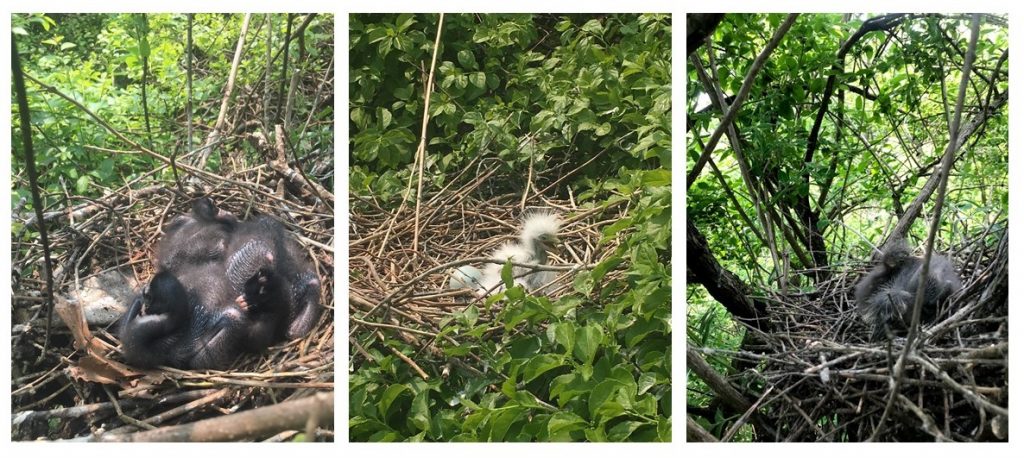
Nests with young, from left to right: glossy ibis; great egret;
black-crowned night-heron.
Great blue herons build the largest nests, they also lay the largest eggs. Many of the great blue heron nests we encountered on the island were higher up than those of other species and built on a snag or tree in direct sunlight.
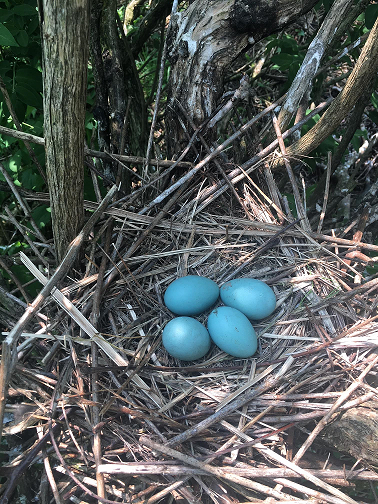
Out of all the wading bird species, we found the most glossy ibis nests. At times, groups of 20 or more ibises could be seen leaving the trees in unison. Their nests are lower in the shrubs and smaller. They’re generally cup-shaped with a deep depression and contain small sticks and lots of vegetative material. Unfortunately, we found many ibis nests that were constructed using plastic, rope, and other garbage that had washed ashore. Glossy ibis eggs tend to be very deep blue in color and teardrop shaped.
Unlike glossy ibises, black-crowned night-herons build their nests using just sticks. These nests tend to be very stable and have small sticks lining the inside and radiating from the center of the nest. Their eggs are very pale and tend to be more green than other species. Great egrets build large, unstable nests with not a lot of cover (similar to great blue heron). Snowy egrets have nests that are slightly smaller and more flat.
-
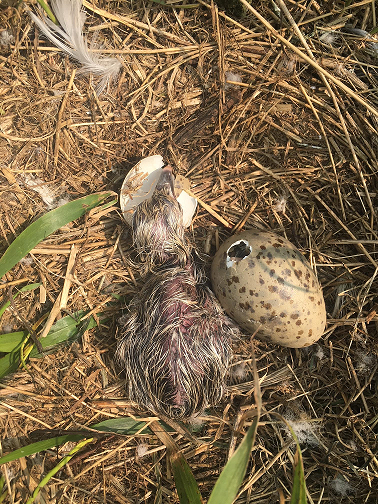
Newly hatched great black-backed gull chick and pipping egg. -
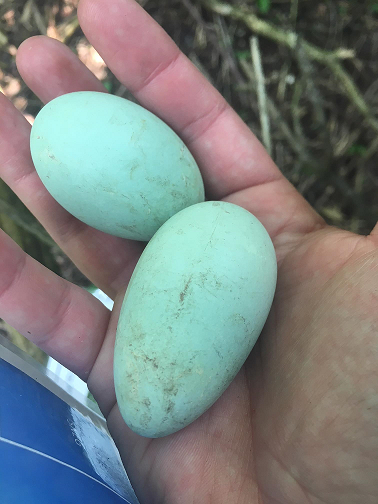
Eggs from the same nest with different shape and size. -
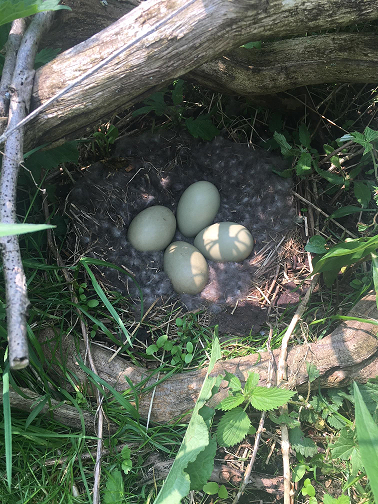
Common eider nest lined with down. -
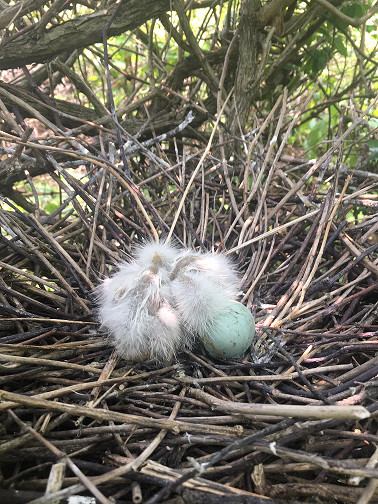
Snowy egret nest with young and an unhatched egg.
All in all, the survey was a huge success. We were able to maneuver around the tangled vines and shrubs to visit the entire island. We found many nests and identified many species. The weather was perfect and the ocean breeze kept all the bugs at bay (no pun intended). After nearly three hours on the island, our small crew of five identified 84 glossy ibis nests, 79 black-crowned-night herons nests, one American crow nest, two great egret nests, 17 snowy egret nests, 11 great blue heron nests, and at least one pair of oystercatchers. Of the nests we saw, about 70% had not hatched yet, most with more than two eggs in them. Herring and great black-backed gulls occupied the shoreline, and many (hundreds) of common eider nests were on the ground all throughout the island. This island may be the most significant northern-most heronry for this suite of species on the east coast. What a great day to be a bird biologist!